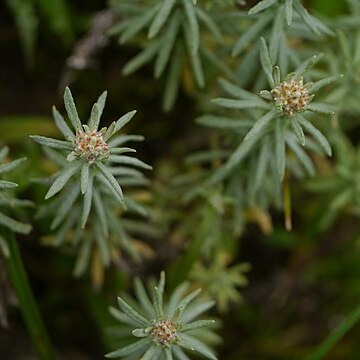Rhizome woody, with solitary or caespitose sobols and flowering stems. Stems erect or ascending, 15-80 cm, somewhat slender, woody at base, virgate, densely white cottony tomentose, lower parts sometimes glabrous or with cottony tomentose axillary buds, rather densely leafy. Lower leaves caducous and lost by anthesis; leaves expanding or explanate, linear, 1.5-6 × 0.4-0.5 cm, larger upward, base cordate and auriculate-clasping, margin revolute, apex acuminate, sometimes with black tip; uppermost leaves small and narrow; all leaves densely whitish tomentose abaxially, arachnoid hairy or glabrous adaxially, midvein somewhat exserted abaxially; leaves oblong-lanceolate or oblanceolate in sobols, long cottony tomentose. Capitula rather numerous, dense, compound corymbiform, terminal on stems and branches; peduncle ca. 3 cm or absent. Involucre campanulate, 5-6 × 4-6 mm; phyllaries 5-or 6-seriate; outer phyllaries slightly fulvous or purple-red, ovate, ca. 2.5 mm, cottony tomentose; middle ones obovate-oblong, ca. 4 mm, rounded at apex, white and ca. 1.2 mm wide in female florets, milky or rarely somewhat red and ca. 1.5 mm wide in male florets; innermost ones spatulate, with a claw ca. 2/3 of full length. Receptacle alveolate. Predominantly female capitula with many florets, with 1-4 central male florets and many rows of marginal female florets; predominantly male capitula with many florets, with all central male florets. Corolla 2.3-3 mm. Pappus almost as long as corolla; male florets pappus somewhat incrassate at tip of apex. Achene oblong, with small glands. Fl. and fr. Aug-Oct. 2n = 28.
More
A herb with a woody rhizome or underground stem. The stems can be erect and 15-80 cm tall. They have a white cottony coating. The leaves are narrow and 2-6 cm long by 4-5 mm wide. The base is heart shaped and clasps the stem. The upper leaves are smaller.
It is a temperate plant. It grows on grasslands between 1,700-3,500 m above sea level in south China.

